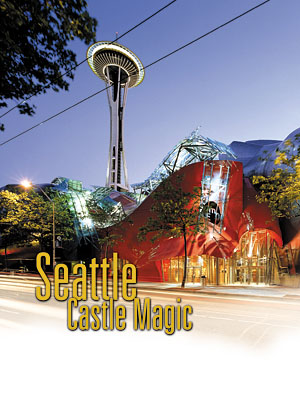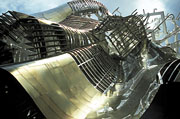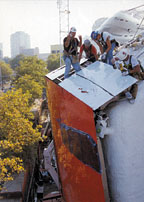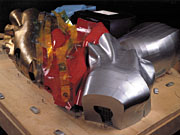

Located at the base of Seattle’s famous Space Needle, EMP is, to say the least, architecturally “unusual.” Its entire exterior is curved. The wall and roof are all one piece (or so it appears) of rounded sheet metal. Walking around the outside of this building is an exercise in bewilderment. At every turn there is some weird curve or bulge or indentation that begs the question, “How did they ever build this thing?”
EMP is the brainchild of Paul Allen, who, with Bill Gates, founded Microsoft. Allen left Microsoft years ago, and is now having an unusual type of money problem: what to do with all of it. A serious rock ’n’ roll aficionado, Allen had another problem: what to do with his enormous collection of rock ’n’ roll memorabilia. His solution: construct his own museum to house all his goodies. One thing led to another, and eventually the museum concept evolved into a new type of building in which the visitors can interact with the building and “experience” music.

Butterflies and zebras, moonbeams and fairytales
EMP strives to provide the at-a-concert experience via its ultra high-tech interactive sound and light systems, while also showcasing thousands of artifacts related to popular music in a museum-like setting. Visitors to EMP wear electronic devices called MEGs over their shoulders like a purse. A MEG is basically a computer, but has a headset and a wand-like gizmo on a cord. The visitor uses the wand to “point” at whatever exhibit he or she is interested in. The wand senses the visitor is in the building, and speaks to him or her with music and background information about the exhibit at hand. Visitors to EMP, in a sense, become their own tour guides. This sort of gadgetry (there’s enough computer data cabling in EMP to circle the globe!) is the soul of this building, and makes visiting EMP a lot of fun.Completed last summer, EMP was designed by Frank Gehry, an internationally known California architect who is famous for his unusual buildings. The GC for the job was Hoffman Construction, a local firm. The interior drywall, plastering, fireproofing and framing work was done by Pacific Construction Systems, also of the Seattle area.
EMP’s structural frame is steel. The exterior wall and roof metal “skin” is supported by an incredibly complex light steel framing system that is attached to the structural frame. While being erected, the structural steel building frame looked like the bones of a dead dinosaur, and created a lot of public interest about what the building would look like when completed. Some enterprising engineer calculated that if the steel used in this building were melted down to make a guitar string, the string would reach from the earth to Venus!
The building’s skin, including the roof, is made of 21,000 overlapping aluminum and stainless steel “shingles.” The shingles vary in size from that of a record album cover to that of a card table. Every shingle is different. They were made in Europe, finished in the UK and the United States, and then shipped to Seattle. The shingles are attached to the wall or roof structure via countersunk screws that went into a light-metal-framing system.
The framing system is supported by an inner, structural wall that is made of a steel deck and is insulated with foam. Hence, the skin of the building (the wall and roof are a series of interconnected continuous curved surfaces) is for looks only. The wall/roof assembly is actually a double-layer system, a necessary approach to make the walls and roofs waterproof. The finish on the shingles is paint in some places, burnished or polished metal in others, or “finished” by exotic metal techniques that result in a peacock-feather-like iridescent quality.
Walls & Ceilings readers might ask, “Why didn’t the architect specify EIFS for the skin of EMP?” With its natural ability to adapt to complex curves, EIFS would seem a natural choice. Gehry’s office provided a simple answer: Trowel-on simply cannot achieve the smooth, vibrant, metallic appearance. Fair enough.
The building has almost no right angles, which made laying out the light-metal framing a challenge. Using computers to figure out what goes where was the only way to go. We’re not talking about PCs, but rather the ultra-powerful CATIA (pronounced “kah-TEE-yuh”) 3-D computer modeling system used by companies like Boeing to design spacecrafts. The shingles on the outside of the supporting framing are curved, but the curving is done by warping the metal—not by permanently bending it—but by cold forming it in place or hand-forming in place. Thus, straight metal studs can be used in many areas to support a three-dimensionally curved skin. Framing contractors might ask: “How can this be done?”

Kick it out
Take a sheet of heavy paper. Roll it into the shape of a funnel. It is possible to lay a straight edge in certain positions along the curved surface of the funnel and still have the straight edge be in contact with the curved surface, right? Now, take the same piece of paper and warp it into an odd, undulating curve. Even with this type of shape, it is still possible to lay straight edges against certain parts of this type of surface, too. The trouble is that the straight supporting pieces must stop and start to maintain in full contact with the warped paper surface.The same is true at EMP. This is why the metal studs stop and start, and hang at odd angles, in the accompanying photographs. Also, when looking at the final skin (the metal shingles) of EMP, it’s easy to see how fitting 21,000 metal shingles onto this building required enormous precision and patience.
Hoffman had to learn to work with and rely on the CATIA system. Lasers and tape measures simply were not up to the task. But in the end, even the CATIA system was not enough. Many building elements had to be hand fitted using hand-made paper and plywood templates. The CATIA system can be used to make ordinary architectural drawings that supply written dimensions for the sizes and spacing of building elements. However, it can also be used to plot the size of shapes at full size. Hoffman often resorted to using full-size templates to “force” the curved pieces to fit because they were more accurate than the dimensions on the drawings. Hence, the old contracting adage of “do not scale the drawings” does not apply fully to buildings like EMP.
This geometry-lesson-on-steroids problem continues indoors. Thousands of square feet of complex wood, metal and plaster surfaces were all created by warping flat materials. Carl Philiber of PCS was proud when he said that it took some real craftsmanship and hands-on ingenuity to build the walls. Anyone in the interior finish and framing business visiting Seattle should take the time to look at some of this work. It is remarkable.
The acoustical design of EMP is as interesting as the walls. As EMP is designed to showcase popular music, the music needs to be played properly, namely loud. It’s one thing to have one concert going on in a big building like this, but it’s quite another to have several happening simultaneously and still retain the tranquillity of a museum.
More proof of the extraordinary acoustics are the open mini-theater-type displays that constantly blare raucous rock ’n’ roll, yet have no doors and are directly adjacent to quiet display spaces! How was it done? Sophisticated acoustical design was combined with modern materials and superior craftsmanship. Another example: the monorail train that connects the Space Needle with downtown Seattle goes through (but not inside) the building, much like shooting an arrow through a doughnut hole. Yet, one hardly knows it’s zipping by as one muses with a MEG in the exhibit areas a few feet from the monorail’s tracks.

Love or confusion
Hoffman and PSC said there were several aspects of doing this project that were particularly challenging. Lack of detail in the architect’s drawings was a start; the drawings were vague as to how the various unusual aspects of construction would fit together. Coordination was a big issue, as no less than seven architects worked on the project. The schedule itself was very aggressive too. The contractors worked day and night.For example, the monorail goes through the outside of the building, and runs from 7 a.m. to 11 p.m. It was thus not possible for safety reasons to work on that part of the building during normal hours; it had to be done at night. In fact, the contractors admitted that they first became aware of the actual completion date for the project in June via a story about EMP in the Seattle newspaper about the MTV gala opening night!
Walls & Ceilings readers interested in the fireproofing aspects of this building will also find EMP an Experience Fireproofing Project. EMP has many large, open, tall spaces. In some areas, the underside of the structural roof deck is exposed. In others, it is protected by ceilings or by spray-on materials. In all, there are three types of fireproofing systems used on this building, which can be seen in some of the dark ceiling areas. In determining what system to use where, problems arose due to the curved shape of all the exterior walls and roof. For example, floor lines in the traditional sense do not exist in many areas at EMP. Thus, deciding where to stop and start the various fireproofing systems was an aesthetic, as well as a safety, issue.
The fireproofing situation at EMP (as well as other code-related issues, such as the structural design calculations for the building’s frame) was so complex that even the building department of a big city like Seattle had to farm out some of the buildings permit review process. Several world-class firms were enlisted to check for code compliance, since determining how an oddball building like EMP fits into the code is not an easy task for any building department. For example, when does the wall stop and the roof start, or how do you determine a weird building frame like EMP’s to withstand earthquake loads?
Is this type of building the architecture of the future? Not a chance. Cost is a major factor. This building defies normal per-square-foot pricing comparisons, but here’s a ballpark idea. The usable public area of EMP is about 120,000 square feet. The EMP building cost in excess of $100 million. You do the math.
Did the building go together without hassles? Of course not, but both Hoffman and PCS agree that it was truly a project to be proud of. When I met with them at the Northwest Wall and Ceiling Bureau’s office in Seattle, I asked if they would do this type of project again. “Absolutely” was the answer, and “It was exhilarating!” In fact, they both said they would search out an opportunity to work on such a project again.
If you are interested in learning more about this amazing building, check EMP’s Web site at www.emplive.com.
Finally, many thanks to following people for their help with the article: the staff of the Northwest Wall and Ceiling Bureau; Dale Stenning of Hoffman, Carl Philiber of PSC; and the friendly PR staff at the EMP building.


Report Abusive Comment